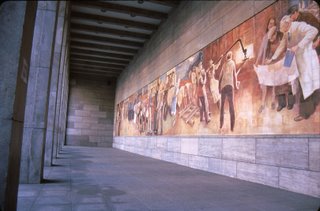As I passed out that evening, I realized that I was now further East than I had ever been before in my life.
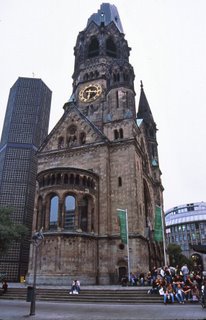 This church at left (Gednactniskirche) is near the main downtown shopping district in the west end of Berlin & remains in its World War II bombed out state as a reminder of the "man's folly & the futility of war".
This church at left (Gednactniskirche) is near the main downtown shopping district in the west end of Berlin & remains in its World War II bombed out state as a reminder of the "man's folly & the futility of war". In the morning, we went on a free 4 hour walking tour of Berlin led by charming fellow from Manchester, England. This is the famous Brandenburg Gate (Brandenburg Tor). Synonymous with Nazi Germany & the symbolic entrance to the city, it is monolithic, imposing, and arresting, to say the least.
In the morning, we went on a free 4 hour walking tour of Berlin led by charming fellow from Manchester, England. This is the famous Brandenburg Gate (Brandenburg Tor). Synonymous with Nazi Germany & the symbolic entrance to the city, it is monolithic, imposing, and arresting, to say the least.Below right, although it may not look like much, is Bebelblatz, the site of the infamous 1933 book burning. The shocking thing is that this was not a Nazi event, but rather hosted by scholars, students, & professors of the University of Berlin, where the square is located.
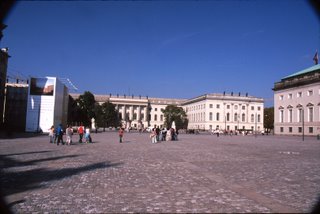

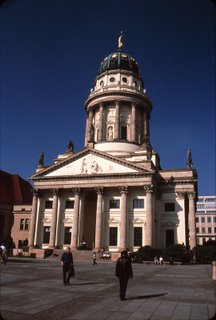


At center & right is the Jewish Holocaust Memorial. Wow. It consists of 2711 concrete stone blocks of varying heights spread out over several acres (about a block from the Brandenburg Gate) that you can wander through like a maze. Amazing. Across the street is the parking lot that stands over Hitler's bunker where he killed himself. I didn't take any pictures of that. Berliners are very sensitive about their past errors - nothing marks the fact the bunker even exists, although, there are rumors that in 50 years or so, they'll dig it up and make it into a Jewish historical library. At left is the Franzosischer Dom (French Cathedral) in Gendarmenmarkt, built by French Huguenots in the early 1700's.
 Above left - good ol' Commie propaganda. At right - the Konzerthaus (Concert Hall) also in Gendarmenmarkt square. Like everything else in Berlin, it was rebuilt in the 80's after being destroyed in WWII.
Above left - good ol' Commie propaganda. At right - the Konzerthaus (Concert Hall) also in Gendarmenmarkt square. Like everything else in Berlin, it was rebuilt in the 80's after being destroyed in WWII.

Here are various views of the Berliner Dom cathedral on "Museum Island" - the current incarnation was built 1894-1905 by Emperor Willem II after he demolished the original, just because he could. (The horse sculpture is on the steps of the Altes museum.)

 The Wall. Left: looking from West Berlin. Right: looking from East. It's not much of a wall these days, but you get the idea of its effectiveness when you're standing there. There used to be an inner and an outer wall, patrolled on top, with a "death zone" in between. And I never realized that West Berlin was walled off in a circular pattern from the rest of the city, either. I guess I always thought of it as a divisional wall, dividing in half, not circling the non-communists.
The Wall. Left: looking from West Berlin. Right: looking from East. It's not much of a wall these days, but you get the idea of its effectiveness when you're standing there. There used to be an inner and an outer wall, patrolled on top, with a "death zone" in between. And I never realized that West Berlin was walled off in a circular pattern from the rest of the city, either. I guess I always thought of it as a divisional wall, dividing in half, not circling the non-communists.
The section of wall that we saw was at Zimmerstrasse, about a block from Checkpoint Charlie - or the tourist trap facsimile of what used to be the checkpoint into the American Zone. Out tour guide was not much of a Charlie fan, since it's all fake. In the evening, on our own, we visited the Reichstag, the seat of German parliament (and the key to Hitler's power grab in 1933). The center of the building has an enormous glass dome that you can climb up and look out over the city. The center is also glass, so you can look down into the parliament chambers below. Germans are big on "transparency of government" - like I said, they're very sensitive and careful about past transgressions, with good reason. The bad rap they get in the US is totally unfounded - they were all very helpful, patient, & extremely polite, and Berlin as a whole is a much more progressive city, at least to my eyes, than any city in this country. (Dear God, there are coffee houses, bookstores, and bier gartens on every block! It's paradise!) 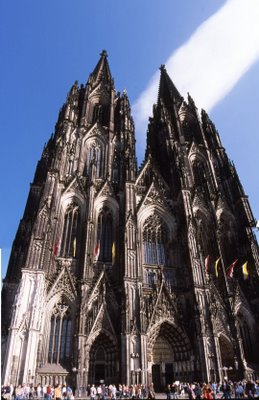 After Berlin, we took a train east across the country to the Rhine valley region (via Hanover & Dusseldorf), stopping in Koln (Cologne) for about 20 minutes between trains. This here is the 700 year old Dom, the massively enormous cathedral literally right outside the Koln Hauptbahnhopf ("main train station" in German).
After Berlin, we took a train east across the country to the Rhine valley region (via Hanover & Dusseldorf), stopping in Koln (Cologne) for about 20 minutes between trains. This here is the 700 year old Dom, the massively enormous cathedral literally right outside the Koln Hauptbahnhopf ("main train station" in German).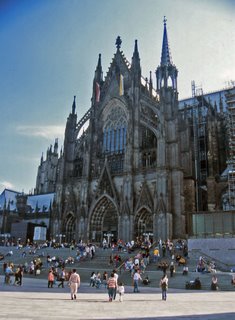
(See, I even learned over there). The Dom was so big, I had to take two separate photos of its facade and Photoshop them together (above left). When someone says "gothic architecture", this thing is what you should visualize. (Above right: the view of the Dom as you step outside the train station.)


From the (apparently baffling) train station in Koln, we went south along the Rhine River valley and stopped in a small town that sounded cool - Koblenz. We were ultimately just headed to Mark's house outside Kaiserslautern, so we were into the meandering thing. Koblenz turned out to be one of my personal favorite stops on our trip. 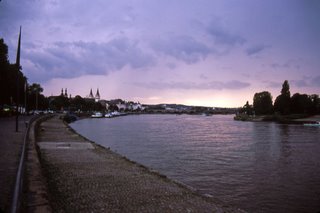



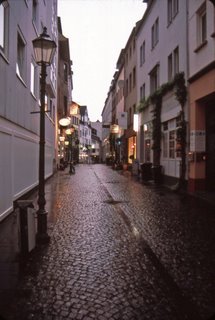
Koblenz is at the confluence of the Rhine and the Mainz Rivers. Koblenzers are very proud of this fact. (left-right, top-bottom) - 1. looking down the Mainz. 2. Looking across the Rhine from Koblenz. 3. The silhouette of the Basilka Saint Kastor, consecrated in 836 AD. 4. The rain swept streets of Koblenz - very euro, no? 5. And the enormous statue of Kaiser Wilhelm I and winged Victory looking out over the confluence of the rivers.
On to Munich: 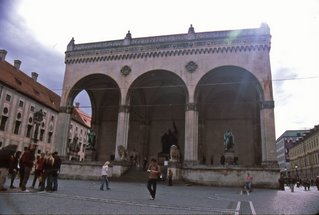

(left) This is the Feldherrnhalle (the "Hall of the Commanders") - built in the 1840's as a symbol of the honors of Bavaria's army. (right) The famous Frauenkirche - Munich's most photographed & well-known landmark. Built in 1494 (with iron onion domes added in 1525), the towers, unlike the rest of Germany, survived WWII completely intact. 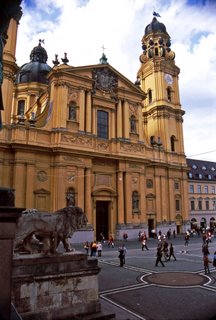
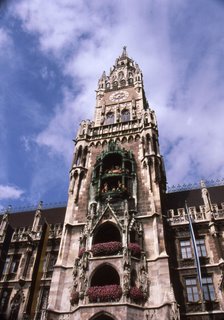
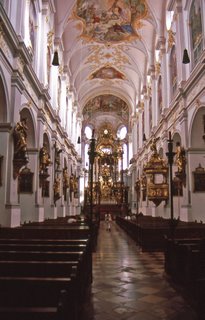
(left) The Italian high-baroque facade of Theatinerkirche (St. Kajetan) viewed from the Feldherrnhalle. (center) The interior of St. Peter's church. There has been a church on this site since before Munich was a city (this one dates to 1368). Jenny is in the center aisle. (right) The Rathaus-Glockenspiel in Marienplatz. Every day, the giant glockenspiel in the tower come to life - 32 life-sized jousters & dancers rock out for the crowds in the square below.
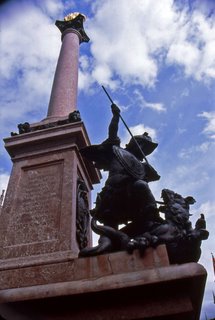


(left) One of the columns in Marienplatz below the glockenspiel. (center) Pretty red leaves in a courtyard of the Residenz - the sprawling royal domicile. (right) Maximillian I of Bavaria welcomes you to the Nationaltheater Munchen, part of the Residenz and where most of Wagner's operas debuted back in the day. 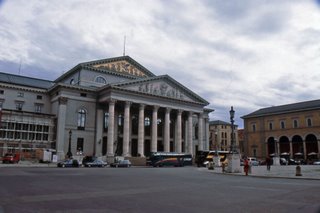
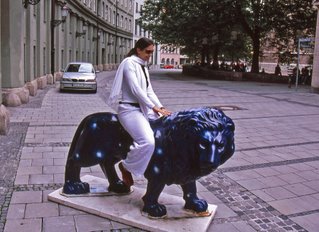
(left) The front of the Nationaltheater. (right) Jenny rides a lion.
We were in Munich on the final day of Octoberfest (Wiesn) and the day before German Reunification day, but I didn't take any pictures inside the festival grounds because my hands were full of liters of beer and bratwursts! Wiesn is like a giant carvival with beer, except there are no fights or bad vibes, like an American carnival - everyone was on the same page: have a good time and get drunk.
After that we took an overnight train to Venice. Ah, Venice. 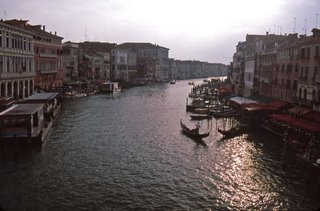
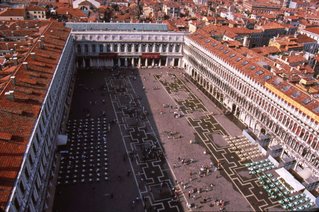
Venice is the most beautiful city I have ever seen in my life.
Left: looking southwest down the Grand Canal from the Rialto Bridge. Right: Piazza San Marco. 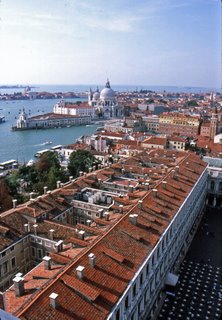
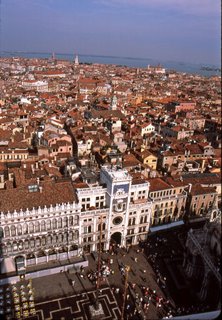

In Piazza di San Marco (the famous square where pigeons feed on the tourists), there is a 280 foot tall bell tower (campanile) that offers you a 360 degree view of the entire city. All the high perspective pics are from the top of the tower. On the right: the white building in the center is the Torre dell'Orologio - a 15th century clock tower that shows 24-hr time, the lunar phase, and the ascending constellations.
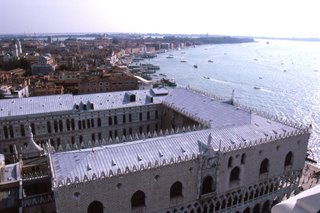
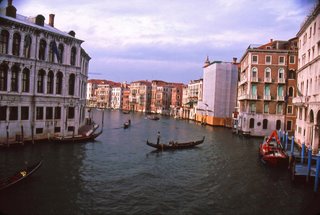
(left) Looking down on the Doge's Palace - the former seat of Venetian power. (aka the "mayor's house".) (right) Looking north up the Grand Canal from the Rialto Bridge.

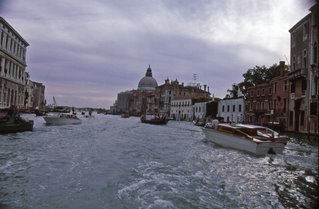
We had a great lunch in a small cafe in a small piazza in the middle of the maze of the city. Very quiet, no tourists. Even though we were aware that there were a lot of tourists around, the city is so spread out that you don't really interact with them as much as you would think. In fact, I think we left most of them with their enormous tour groups and the pigeons in Piazza San Marco. (right) The Grand Canal.
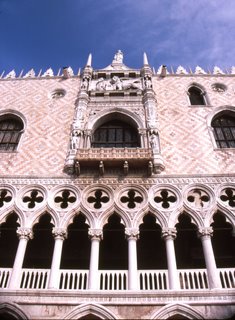
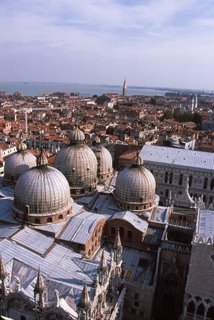
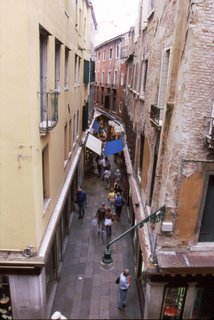 (left) The "Lion's Mouth" on the Doge's Palace - where the Doge's Council of Ten would pass their judgements on "guilty" parties. The Ten would also hang said guilty folks in wooden cages off of the top of the bell tower in the piazza. (center) This was the view out our hotel window. (right) The domed rooftops of the Basilica di San Marco. The entire interior of the basilica is covered in amazing 12th c. mosaic tile work - floor to ceiling. They also say that the mortal remains of St. Mark are interred the church. We went inside, but didn't want to pay extra to look at his corpse. The church is also the best (or worst, depending on how you look at it) example of how Venice is slowly sinking into the sea. The beautiful tiled entryway is completely submerged at high tide and visitors have to cross the water on raised wooden platforms. Very sad.
(left) The "Lion's Mouth" on the Doge's Palace - where the Doge's Council of Ten would pass their judgements on "guilty" parties. The Ten would also hang said guilty folks in wooden cages off of the top of the bell tower in the piazza. (center) This was the view out our hotel window. (right) The domed rooftops of the Basilica di San Marco. The entire interior of the basilica is covered in amazing 12th c. mosaic tile work - floor to ceiling. They also say that the mortal remains of St. Mark are interred the church. We went inside, but didn't want to pay extra to look at his corpse. The church is also the best (or worst, depending on how you look at it) example of how Venice is slowly sinking into the sea. The beautiful tiled entryway is completely submerged at high tide and visitors have to cross the water on raised wooden platforms. Very sad.(above left-right) 1. Facing the Bridge of Sighs (at the far end of the canal) behind the Doge's palace & next to the former prison complex. The condemned Casanova walked the bridge en route to prison. 2. La Fenice Opera House. I read the book City of Falling Angels by John Berendt and went to Venice to see La Fenice for myself. Arson and all, it looks pretty good. 3. The Gallerie dell'Accademia on the Grand Canal. On the same block as Peggy Guggenheim's place. 4. Doge's Palace from the Grand Canal. 5. Jenny.
Then to Florence - a slight change of pace...lots and lots of cars, mostly.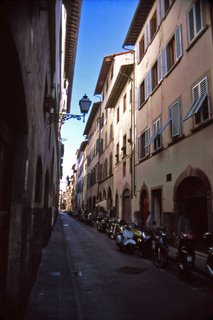

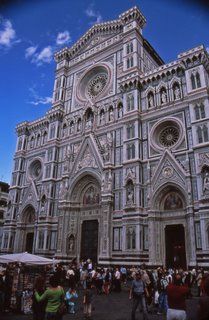
(above left) Via Dei Moro - the street where we eventually ended up staying in Florence. (Our journey to accomodations is a long, not very exciting story that involved a lot of unnecessary walking up and down stairs with heavy packs, tricky hotel managers, and three frustrated tourists.) But once that part was over, we went into the center of the city - really only about 4 blocks from the hotel - where the massive Duomo presides (center). In this piazza - the only part of Florence without those damn motorbikes zipping around - are three gigantic red, green, & white marble buildings. (right) The backside of the Duomo - also known as Brunelleschi's Dome. No photograph really does this unbelievably large structure any justice. The exterior marble work is just mindblowing.

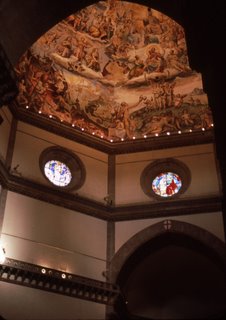
 (above left) "Giotto's Tower" in the Piazza del Duomo. Designed by Giotto, and built by Renaissance architectural geniuses, Pisano & Talenti, it has the same green, red, & white marble facade as the Duomo. (center) The Duomo at dusk. (right) The interior of Brunelleschi's famed dome - complete with visions of the apocalypse glaring down on the visiting sinners.
(above left) "Giotto's Tower" in the Piazza del Duomo. Designed by Giotto, and built by Renaissance architectural geniuses, Pisano & Talenti, it has the same green, red, & white marble facade as the Duomo. (center) The Duomo at dusk. (right) The interior of Brunelleschi's famed dome - complete with visions of the apocalypse glaring down on the visiting sinners.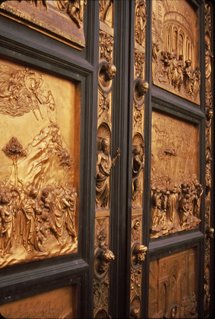
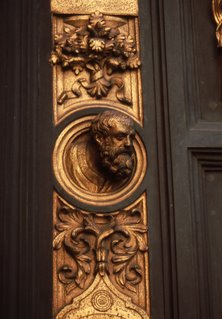 On either side here are the famed brass doors to the Battistero across the piazza from the Duomo. The building has 4 sets of doors like this - these, definitely the superior of the lot, were built by Ghiberti in 1425. An impressed Michelangelo reportedly dubbed them the "Gates of Paradise" and the name stuck - deservedly so. They are utterly magnificent.
On either side here are the famed brass doors to the Battistero across the piazza from the Duomo. The building has 4 sets of doors like this - these, definitely the superior of the lot, were built by Ghiberti in 1425. An impressed Michelangelo reportedly dubbed them the "Gates of Paradise" and the name stuck - deservedly so. They are utterly magnificent.
Fun fact: Dante was christened inside this building, originally a baptistry.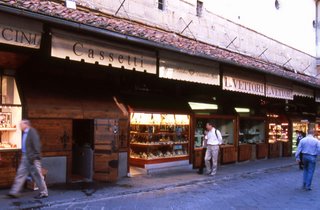
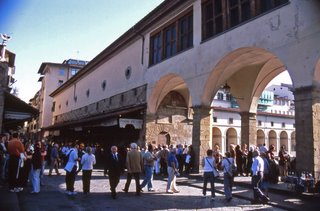
The Ponte Vecchio - the oldest bridge in Florence (c.1345). When it first opened, the bridge was home to all the butchers in town, who would dump pig guts & blood into the Arno river. The Medici family, the bosses of Florence, weren't down with this, so they evicted all the meat boys in favor of gold merchants. That's the same way we found the bridge today. Each gold shop has a medieval-looking wood & iron door that locks down after hours (above left) - they each have peep holes in the doors so you can view the wares at night.

The Ponte Vecchio spanning the Arno. (right) Via Dei Moro - the street in Florence where we eventually ended up staying. Imagine a car or a motorcycle speeding down this alley towards you.
 (left) A dude on a horse statue in a piazza near the Accademia - where David lives. They don't allow photos inside the Accademia, so you'll have to use your imagination. Besides, no photograph has ever done David an ounce of justice. I was floored by it. (right) Another statue/fountain in the piazza behind the Accademia. I thought the evil monkey spitting water on the top was pretty cool.
(left) A dude on a horse statue in a piazza near the Accademia - where David lives. They don't allow photos inside the Accademia, so you'll have to use your imagination. Besides, no photograph has ever done David an ounce of justice. I was floored by it. (right) Another statue/fountain in the piazza behind the Accademia. I thought the evil monkey spitting water on the top was pretty cool.In the evening, we wandered arround the Ponte Vecchio and the Uffizi museum on the Piazza Della Signora. The Uffizi is a massive complex, by the way, and we didn't really have the time during our stay to wait in the insane line to get in in the morning. The Piazza Della Signora has the Loggia dei Lonzi - an open sided building housing a copy of Giambologna's spectacular Rape of the Sabine Women marble statue. In the morning, we wandered over the Vecchio, had some breakfast on the other side of the Arno, then headed to Rome.

 After Florence, Rome was a comparative breeze to deal with. We headed right to our pensione, just a few blocks from the train staion. The signora there was great - we were actually staying in a townhouse she owned on Piazza Dante, closer to the Forum etc - we sipped espresso while we waited for her husband to arrive with the car. The townhouse was fantastic - spacious, clean, comfortable. (& there was actually a German couple staying in the other room there, so Mark had someone to practice on while out of Germany.)
After Florence, Rome was a comparative breeze to deal with. We headed right to our pensione, just a few blocks from the train staion. The signora there was great - we were actually staying in a townhouse she owned on Piazza Dante, closer to the Forum etc - we sipped espresso while we waited for her husband to arrive with the car. The townhouse was fantastic - spacious, clean, comfortable. (& there was actually a German couple staying in the other room there, so Mark had someone to practice on while out of Germany.) By the time we settled in, most of the day was gone (it was close to 3 or 4) so we decided to walk the 20 minutes to the Colosseum and see what we could see. above left: We approached the Colosseum from the southeast - this was my first close view. Magnificent. center: Jenny wanders the Palatine Hill - where Rome began. right: The Arch of Constantine. Constantine liked to build stuff. This arch is right outside the Colosseum & commemorates Consti's victory of the Milvian Bridge in 312AD. You're going to have to go ahead & Google that one, I don't know what happened there.
left: A kitty cat wanders the ancient streets of the Palatine Hill. above right: The Roman Forum. Serious building started here around 750 BC.
Lets go to the Colosseum!






 (above) The floor of the Colosseum - a warren of passageways & old tunnels where they used to keep animals, gladiators, & Christians below the floor of the arena, ready to take the elevator upstairs. So, in Gladiator, when the tiger emerges out of the ground during one of Russell Crowe's fight scenes...that really would have happened.
(above) The floor of the Colosseum - a warren of passageways & old tunnels where they used to keep animals, gladiators, & Christians below the floor of the arena, ready to take the elevator upstairs. So, in Gladiator, when the tiger emerges out of the ground during one of Russell Crowe's fight scenes...that really would have happened.
(right) I think this was my favorite Roman moment - the light streaming through this ancient archway was perfect.
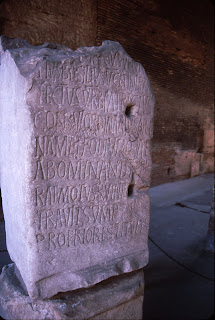
We were lucky enough to exit the Colosseum just as the fabled photographic "magic hour" hit. Check out that facade.
 Since the sun was setting, we decided to save the Forum until the next day & walked up Via dei Fori Imperioli with the Forum of Trajan on our north side. This area is a perfect example of what modern Rome is like - ruins from 107 AD in the foreground, apartment buildings from 1995 in the back. All layers of the city's history coexist.
Since the sun was setting, we decided to save the Forum until the next day & walked up Via dei Fori Imperioli with the Forum of Trajan on our north side. This area is a perfect example of what modern Rome is like - ruins from 107 AD in the foreground, apartment buildings from 1995 in the back. All layers of the city's history coexist.
(left) Trajan's Column stands in the center. Until 1588, when the Church got their hands on it, it had a statue of Trajan on the top. Now, it's Saint Peter.
 (left) This behemoth was directly across the street from Trajan's Column. It looks ancient, I know, but the Monumento a Vittorio Emanuele II was built between 1895-1911 to honor the first king of unified Italy. The really crappy part is that they leveled most of the ancient Capitoline Hill to build it. As a result, most Romans resent it and think its too overpowering & pompous, considering that it sits at the end of the magnificent Forum. They call it "the wedding cake" or my favorite, "the false teeth". (left) Jen & Mark at the Trevi Fountain - spectacular at night, despite the crowds. Following tradition, Jen & I threw coins over our shoulders for luck - Mark has that picture. From Trevi we walked over to (and up) the Spanish Steps, which afforded a great view of Rome at night. At the bottom of the steps is a fountain of drinking water flowing from an old Roman aqueduct, so we had a drink while we were there.
(left) This behemoth was directly across the street from Trajan's Column. It looks ancient, I know, but the Monumento a Vittorio Emanuele II was built between 1895-1911 to honor the first king of unified Italy. The really crappy part is that they leveled most of the ancient Capitoline Hill to build it. As a result, most Romans resent it and think its too overpowering & pompous, considering that it sits at the end of the magnificent Forum. They call it "the wedding cake" or my favorite, "the false teeth". (left) Jen & Mark at the Trevi Fountain - spectacular at night, despite the crowds. Following tradition, Jen & I threw coins over our shoulders for luck - Mark has that picture. From Trevi we walked over to (and up) the Spanish Steps, which afforded a great view of Rome at night. At the bottom of the steps is a fountain of drinking water flowing from an old Roman aqueduct, so we had a drink while we were there.

 The next day we went to the Vatican. The piazza in front of St. Peter's basilica is lined with the impressive statues of 140 saints and Christ himself.
The next day we went to the Vatican. The piazza in front of St. Peter's basilica is lined with the impressive statues of 140 saints and Christ himself.
We attempted to see the Sistine Chapel, but it was about a 4 hour wait...no thanks, maybe next time.
I didn't think that any of my photos inside St. Peter's would come out, so there aren't many. There is a lot of the following: crowds of faithful, beautiful mosaic tile work (the walls have no paint, just billions of tiny tiles), statues of every pope throughout history (very fascinating, actually), and gold, gold, gold. Also, Michelangelo's Pieta is there - behind bulletproof glass after some whacko went at it with an axe back in the 70's - and is much smaller than I imagined it would be. Also included with some of the pope statues in little pope alcoves are the actual popes themselves! Some look like the've been dipped in precious metals - one silver pope looked like one of Tobias Funke's disguises. At the front altar are 4 gigantic bronze statues of super-bishops fighting evil on the rays of heaven's glory - at least that's what it looked like to me. Very spectacular. There is also a rather extensive papal museum of reliquery devoted to items bestowed on the Church in St. Peter's name over the last 1500 years. A crapload of gold, in other words. And lots of pieces of the cross of Christ and Saint So-and-so's tooth in elaborate gold chalices. After walking through this museum for over 45 minutes, it got to be a bit much, actually. Any one of those gold goblets melted down would feed Guatemala for like a year.
In the basement are the tombs of the popes - also historically interesting. There were a lot of mourners in front of John Paul II's spot, but otherwise it was just a very old mausoleum. Just outside the walls of Vatican City - south of St. Peter's - is the Castel Sant'Angelo (below, left), built by Hadrian in the first century AD as a mausoleum for himself & his family. Hadrian clearly had an affinity for large chunks of stone. (The big wall below is also one of his.) The whole complex was re-dedicated to an angel that Pope Gregory the Great saw on the roof during a plague outbreak in 590.

 From there we meandered through the streets to the fabled Pantheon (right). Again, Hadrian really, really liked to built stuff out of stone. This dates to around 120AD. Before I left the States, I had a discussion with my sister about this building - and whether it was in Rome or somewhere in Greece. Yeah, the Greek one is the Parthenon and looks pretty much just like this only bigger and on top of a big hill. She was right, but I got to see this one in person.
From there we meandered through the streets to the fabled Pantheon (right). Again, Hadrian really, really liked to built stuff out of stone. This dates to around 120AD. Before I left the States, I had a discussion with my sister about this building - and whether it was in Rome or somewhere in Greece. Yeah, the Greek one is the Parthenon and looks pretty much just like this only bigger and on top of a big hill. She was right, but I got to see this one in person.
No one is sure, even today, how the Pantheon was built. The interior of the dome (which you can see the outside of, just barely, below right) looks like layers upon layers of poured cement or concrete and has a hole in the ceiling to allow sunlight to stream through. The exterior, with the exception of the stellar columns, was stripped of all its marble work when the Church was building the Vatican and St. Peter's basilica. Nice. Buried inside (1400 years ago, Constantine had it consecrated) are the painter Raphael, King Vittorio Emanuelle II, the first king of unified Italy, and his wife, Queen Margherita, namesake of my favorite pizza. There was something amazing about walking down a narrow street and having it open up onto a piazza housing this unbelievable building with "M.Agrippa" etched into the facade.
Just up the block from the Pantheon is this odd Bernini elephant column in a quiet piazza (above center). Also, a few blocks away is this scene that perfectly encapsulates Rome, modern and ancient (above right). A sign next to this ruin states that this was the square where Julius Caesar was betrayed and murdered, but we also came across another spot in the Forum later that said the same thing. I have no idea, but this one was filled with cats!
